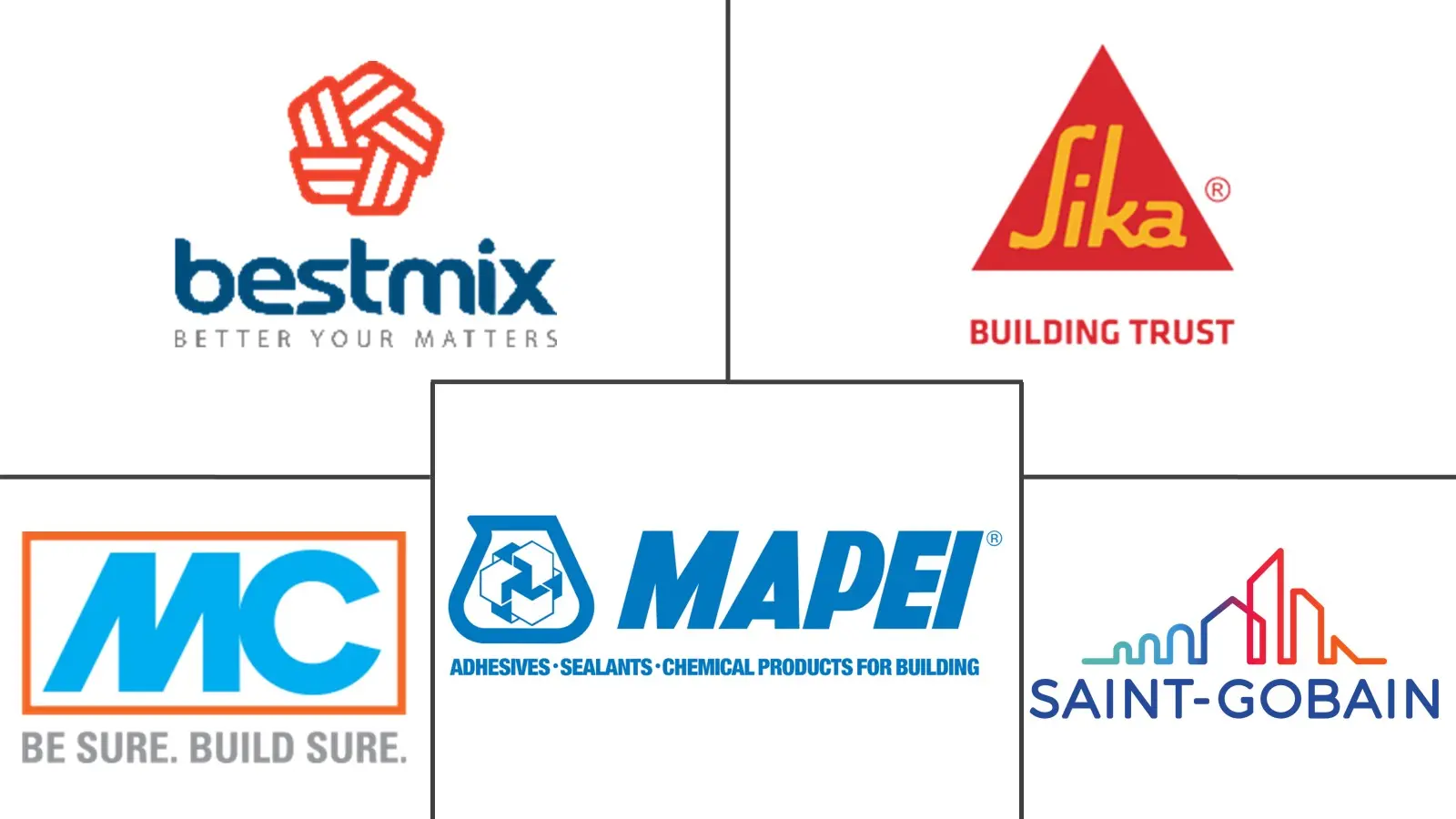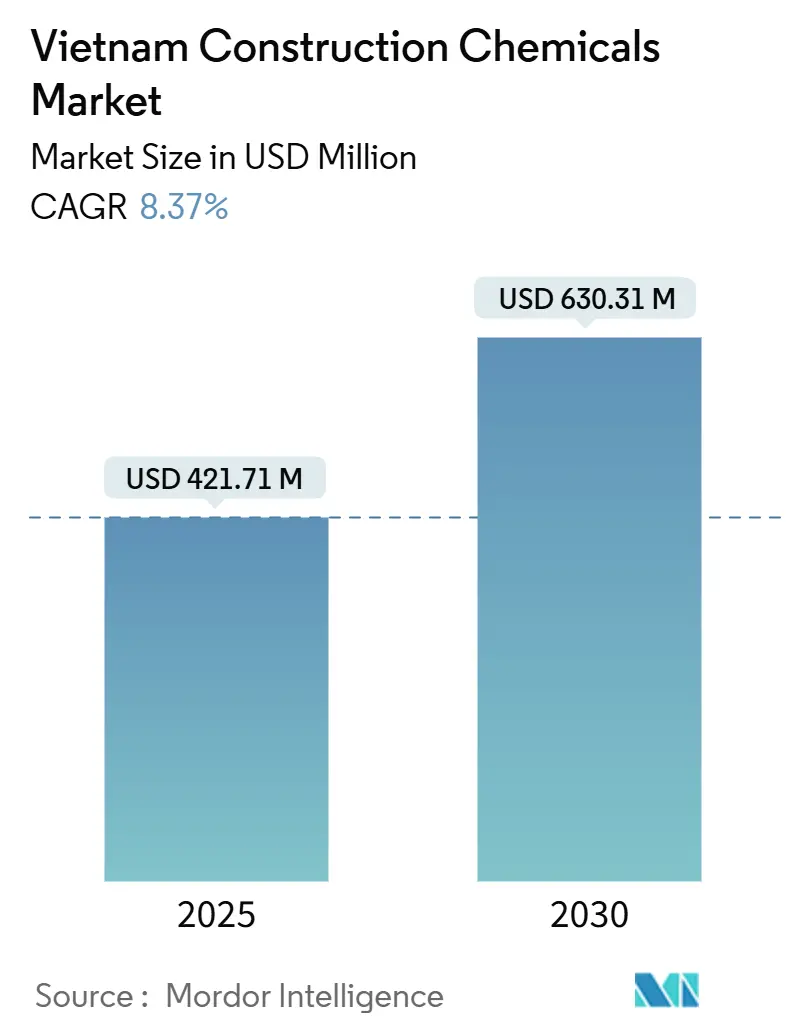
Vietnam Construction Chemicals Market Analysis by Mordor Intelligence
The Vietnam Construction Chemicals Market size is estimated at USD 421.71 million in 2025, and is expected to reach USD 630.31 million by 2030, at a CAGR of 8.37% during the forecast period (2025-2030). Robust infrastructure spending under the government’s VND 791 trillion public investment plan, coupled with USD 23.15 billion of foreign direct investment (FDI) inflows in 2024, underpins sustained demand for high-performance chemical formulations. Developers are pursuing waterproofing and durability solutions to address Vietnam’s monsoon climate, while low-carbon concrete admixtures are gaining traction as the country advances toward achieving net-zero status by 2050. Contractors are adopting digitalized dosing equipment that cuts material waste by up to 20%, widening the performance gap between premium and commodity offerings. Meanwhile, Circular 10/2024/TT-BXD tightens quality standards, elevating entry barriers for non-compliant suppliers.
Key Report Takeaways
- By product category, waterproofing solutions captured 45.65% of the Vietnam construction chemicals market share in 2024. Surface-treatment chemicals are forecast to expand at an 8.55% CAGR through 2030.
- By end-user sector, the commercial segment held 40.31% of the Vietnam construction chemicals market size in 2024. Industrial and institutional applications are projected to advance at an 8.61% CAGR through 2030.
Vietnam Construction Chemicals Market Trends and Insights
Driver Impact Analysis
| Driver | (~) % Impact on CAGR Forecast | Geographic Relevance | Impact Timeline |
|---|---|---|---|
| Infrastructure-led public-sector spending surge | +2.8% | Nationwide, SKER & NKER | Medium term (2-4 years) |
| Rapid expansion of foreign-invested industrial parks | +2.1% | Binh Duong, Dong Nai, Ba Ria-Vung Tau | Long term (≥ 4 years) |
| Adoption of low-carbon concrete admixtures | +1.5% | Ho Chi Minh City, Hanoi, Da Nang | Medium term (2-4 years) |
| Digitalized job-site dosing and QA systems | +1.2% | Major metros & industrial zones | Short term (≤ 2 years) |
| Circular-economy demand for rice-husk-ash nano-silica | +0.7% | Mekong Delta & nationwide | Long term (≥ 4 years) |
| Source: Mordor Intelligence | |||
Infrastructure-led Public-Sector Spending Surge
Public investment officially approved at USD 67 billion for 2025 is redirecting cash toward airports, seaports, metros, and expressways. Large concrete volumes, rigid project-delivery schedules, and tighter quality control standards under TCVN and QCVN codes are incentivizing contractors to specify high-range water reducers, rapid-set repair mortars, and corrosion-inhibiting coatings. Suppliers with a track record of on-time logistics and job-site technical support already report double-digit order backlogs for 2026. The Vietnam construction chemicals market, therefore, links directly to state capital expenditure plans that favor global-standard materials[1]Vietnam Investment Review, “Vietnam industrial parks expansion drives FDI growth in 2024,” vir.com.vn.
Rapid Expansion of Foreign-Invested Industrial
Realized FDI hit USD 21.68 billion in 2024, and 221 additional industrial parks are scheduled before 2030. Singaporean, Chinese, and Korean manufacturers building electronics, batteries, and semiconductors require antistatic floors, chemical-resistant linings, and moisture-tolerant grouts that preserve GMP certifications. Each new VSIP phase consumes 15,000-20,000 tons of admixtures, sealers, and floor toppings. Product managers that align formulations with ISO 14644 clean-room norms are converting inquiries into multi-year supply contracts, reinforcing upside for the Vietnam construction chemicals market through 2030.
Adoption of Low-Carbon Concrete Admixtures
Vietnam’s 2050 net-zero pledge is filtering down to job-site procurement lists. Products that lower embodied CO₂ by integrating rice-husk ash or blast-furnace slag are shifting from pilot tests to mainstream bids. Saint-Gobain’s DURAflex cement board line demonstrates that a 20% carbon cut can coexist with superior edge durability, prompting specifiers to add bio-based plasticizers and viscosity-modifying agents to tender documents. This trend presses every producer in the Vietnam construction chemicals market to publish environmental product declarations and secure green-label certifications.
Digitalized Job-Site Dosing and QA Systems
Automated admixture dispensers, PLC-linked pumps, and cloud-based traceability dashboards now arrive bundled with large-volume supply agreements. Early adopters in Ho Chi Minh City improved batch consistency by 15-25% and cut waste up to 20%. The Ministry of Construction’s BIM mandate forces stakeholders to log chemical usage in federated models, strengthening the business case for integrated dosing solutions. These innovations add a competitive moat for suppliers that invest in software interfaces compatible with Revit and Tekla, giving them a recurring-service revenue stream within the Vietnam construction chemicals market.
Restraint Impact Analysis
| Restraint | (~) % Impact on CAGR Forecast | Geographic Relevance | Impact Timeline |
|---|---|---|---|
| Volatile cement and petro-chemical feedstock prices | -1.8% | Nationwide; higher in north | Short term (≤ 2 years) |
| Fragmented contractor purchasing practices | -1.1% | Nationwide SMEs | Medium term (2-4 years) |
| Slow harmonization of national product standards | -0.9% | Nationwide | Long term (≥ 4 years) |
| Source: Mordor Intelligence | |||
Volatile Cement and Petro-Chemical Feedstock Prices
PVC resin spiked 15-20% within three months when crude oil rose in 2024. Cement utilization dipped from 58% in 2022 to 55% in 2023. Clinker export taxes trimmed producer margins, forcing admixture formulators to renegotiate quarterly prices. Smaller brands in the Vietnam construction chemicals market with low inventory buffers absorb the greatest shocks, often delaying innovation spending until cost curves stabilize.
Fragmented Contractor Purchasing Practices
Thousands of small contractors purchase through informal channels, prioritizing upfront price instead of life-cycle performance. Distributors estimate that 60-70% of product is sold without technical supervision, leading to misapplication and callbacks. This fragmentation hampers adoption of premium systems, creates payment delays, and raises warranty risk for suppliers. The Vietnam construction chemicals industry thus spends disproportionate resources on field trainings, mock-ups, and demo days to counteract low specification discipline.
Segment Analysis
By Product: Waterproofing Solutions Lead Infrastructure Resilience
Waterproofing solutions held 45.65% of the Vietnam construction chemicals market share in 2024, with high-elasticity membranes specified for basements built three meters below sea level in Ho Chi Minh City. Surface-treatment chemicals, helped by automated sprayers and QA sensors, are set to outpace the broader Vietnam construction chemicals market at an 8.55% CAGR.
Contractors increasingly pair silane-siloxane repellents with nano-silica sealers to achieve double-digit reductions in water absorption. Concrete admixtures remain indispensable for expressway girders; super-plasticizers ensure slump retention under 35°C site temperatures common along the central coast. Repair formulations grow as aging bridges along National Route 1 require chloride-resistant mortars. Flooring resins, especially ESD-safe epoxies, move into electronics clusters north of Hanoi, signaling diversification beyond legacy cement-centric products.
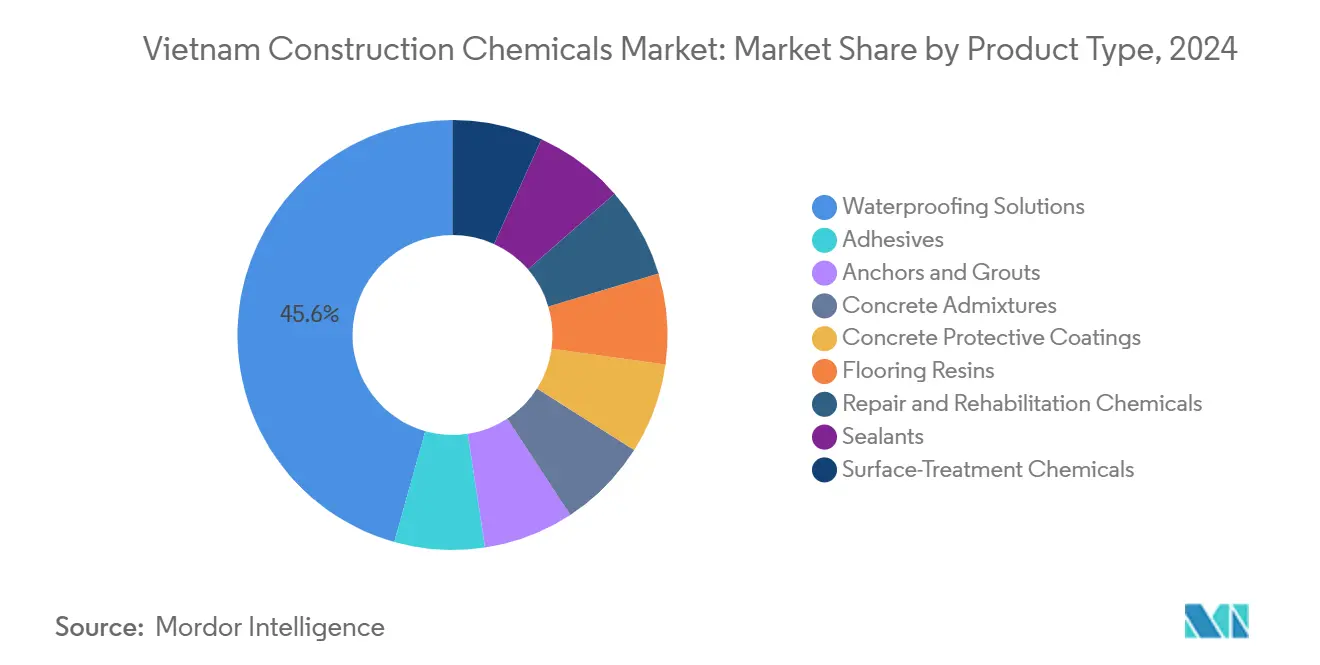
Note: Segment shares of all individual segments available upon report purchase
By End-Use Sector: Commercial Projects Drive Market Leadership
The commercial segment accounted for 40.31% of the Vietnam construction chemicals market size in 2024, anchored by premium office towers and mixed-use malls in District 1 and Ba Dinh. Industrial and institutional projects, spanning 435 zones and 563 parks, lead growth at an 8.61% CAGR through 2030. The Vietnam construction chemicals market share for industrial flooring exceeded 18% in 2024, reflecting the stringent cleanroom specifications of electronics investors.
Residential builders adopt crystalline waterproofers and low-odor acrylic paints as middle-income homeowners prioritize comfort. Infrastructure projects—from the Ben Luc–Long Thanh bridge to metro line tunnels—consume high volumes of sulfate-resistant grouts and corrosion-inhibitor sprays. Segment dynamics reveal distinct buying criteria: industrial park managers value chemical resistance and compliance, while retail developers weigh aesthetics and maintenance cycles.
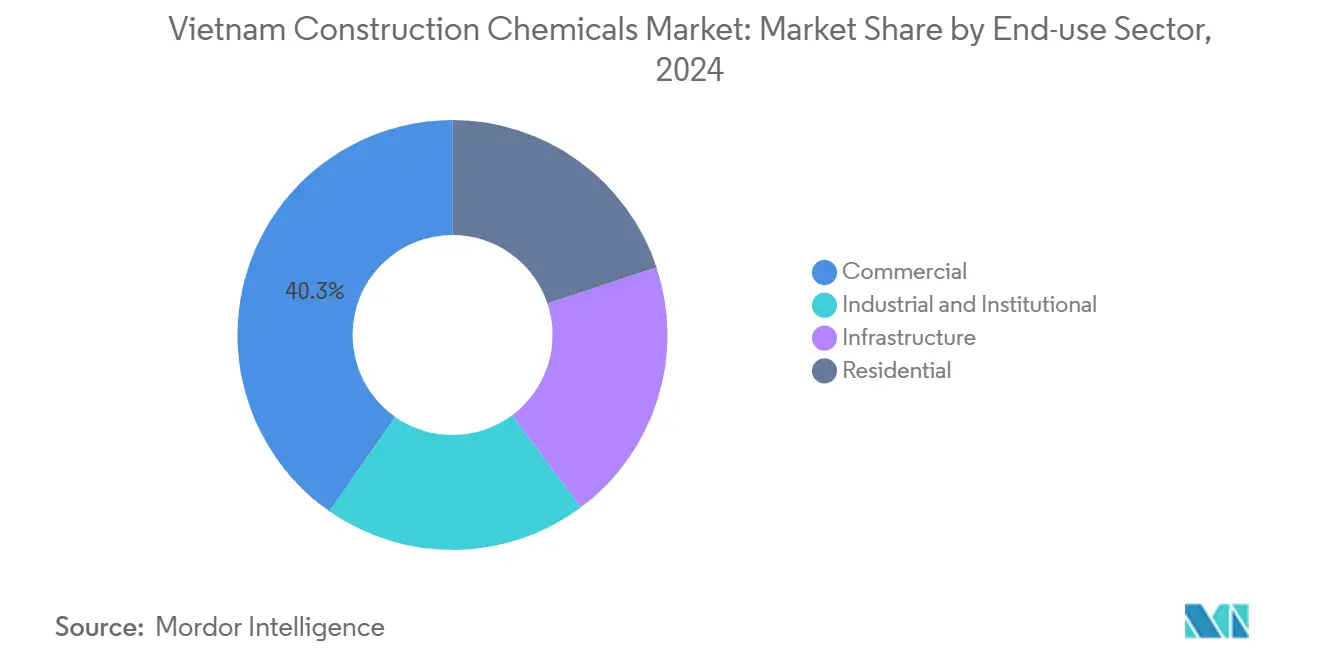
Note: Segment shares of all individual segments available upon report purchase
Geography Analysis
The southern hub attracts mega-projects like Thu Thiem 2 Bridge, Long-Thanh International Airport, and multiple VSIP estates that each specify large quantities of shrinkage-compensating grouts and liquid waterproofers. Local distributor density and port proximity shorten lead times, giving the Vietnam construction chemicals market in the south a logistical edge[2]Vietnam Investment Review, “Vietnam targets infrastructure investment increase to 7% of GDP,” vir.com.vn .
Hanoi and the surrounding northern provinces' current demand benefits from government-funded rail, ring-road, and social-housing schemes. Stronger winter seasonality in the north prompts higher use of accelerating admixtures to maintain setting times below 24 hours. Bac Ninh and Hai Phong, home to electronics clusters, consume epoxy floors and antistatic linings for clean-room compliance.
Saint-Gobain’s Quang Tri panel plant demonstrates how local manufacturing of low-carbon boards translates into regional sourcing advantages for hotels and resorts that brand themselves as eco-friendly. Coastal provinces from Khanh Hoa to Ba Ria-Vung Tau install thick-film polyurea coatings and sulfate-resistant cementitious repair mortars to extend marine asset service life. The Mekong Delta remains fragmented, with small and medium roadworks and agro-processing projects representing incremental upside for affordable, easy-to-apply powders and emulsions.
Competitive Landscape
The Vietnam construction chemicals market features a moderately fragmented field. Sika builds reach through 140-plus authorized outlets, enabling 24-hour delivery cycles in most Tier-1 and Tier-2 cities. Mapei differentiates with specialty tile adhesives rated for high moisture and saline exposure. Fosroc leverages airport and metro references to position its spray-applied polyurea membranes in infrastructure bids. Bestmix uses three domestic plants to serve fast-moving SKUs like non-shrink grouts, offering pricing 8-12% below imported equivalents. Emerging disruptors include local tech start-ups that bundle BIM plug-ins with dosage equipment, aiming to lock in after-sales analytics contracts.
Vietnam Construction Chemicals Industry Leaders
-
MAPEI S.p.A
-
MC-Bauchemie
-
Saint-Gobain
-
Sika AG
-
BESTMIX CORPORATION
- *Disclaimer: Major Players sorted in no particular order
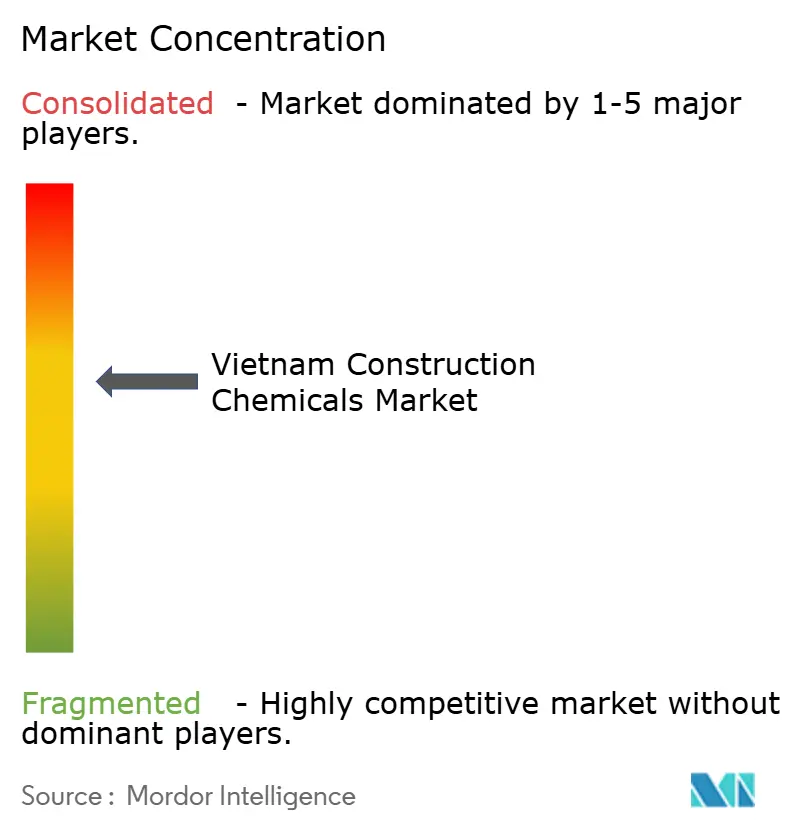
Recent Industry Developments
- July 2025: The National Assembly of Vietnam passed the revised Law on Chemicals (No. 69/2025/QH15), tightening hazardous-chemical controls and mandating digital reporting. The law takes effect on Jan 1, 2026.
- February 2025: Saint-Gobain finalized its USD 1.025 billion purchase of Fosroc, thus expanding its business in the construction chemicals market in Vietnam.
Vietnam Construction Chemicals Market Report Scope
Commercial, Industrial and Institutional, Infrastructure, Residential are covered as segments by End Use Sector. Adhesives, Anchors and Grouts, Concrete Admixtures, Concrete Protective Coatings, Flooring Resins, Repair and Rehabilitation Chemicals, Sealants, Surface Treatment Chemicals, Waterproofing Solutions are covered as segments by Product.| Adhesives | Hot-Melt |
| Reactive | |
| Solvent-borne | |
| Water-borne | |
| Anchors and Grouts | Cementitious Fixing |
| Resin Fixing | |
| Concrete Admixtures | Accelerator |
| Air-Entraining | |
| Super-plasticizer | |
| Retarder | |
| Shrinkage-Reducer | |
| Viscosity-Modifier | |
| Plasticizer | |
| Other Types | |
| Concrete Protective Coatings | Acrylic |
| Alkyd | |
| Epoxy | |
| Polyurethane | |
| Other Resins | |
| Flooring Resins | Acrylic |
| Epoxy | |
| Polyaspartic | |
| Polyurethane | |
| Other Resins | |
| Repair and Rehabilitation Chemicals | Fiber-Wrapping Systems |
| Injection Grouting | |
| Micro-concrete Mortars | |
| Modified Mortars | |
| Rebar Protectors | |
| Sealants | Acrylic |
| Epoxy | |
| Polyurethane | |
| Silicone | |
| Other Resins | |
| Surface-Treatment Chemicals | Curing Compounds |
| Mold-Release Agents | |
| Other Types | |
| Waterproofing Solutions | Chemicals |
| Membranes |
| Commercial |
| Industrial and Institutional |
| Infrastructure |
| Residential |
| By Product | Adhesives | Hot-Melt |
| Reactive | ||
| Solvent-borne | ||
| Water-borne | ||
| Anchors and Grouts | Cementitious Fixing | |
| Resin Fixing | ||
| Concrete Admixtures | Accelerator | |
| Air-Entraining | ||
| Super-plasticizer | ||
| Retarder | ||
| Shrinkage-Reducer | ||
| Viscosity-Modifier | ||
| Plasticizer | ||
| Other Types | ||
| Concrete Protective Coatings | Acrylic | |
| Alkyd | ||
| Epoxy | ||
| Polyurethane | ||
| Other Resins | ||
| Flooring Resins | Acrylic | |
| Epoxy | ||
| Polyaspartic | ||
| Polyurethane | ||
| Other Resins | ||
| Repair and Rehabilitation Chemicals | Fiber-Wrapping Systems | |
| Injection Grouting | ||
| Micro-concrete Mortars | ||
| Modified Mortars | ||
| Rebar Protectors | ||
| Sealants | Acrylic | |
| Epoxy | ||
| Polyurethane | ||
| Silicone | ||
| Other Resins | ||
| Surface-Treatment Chemicals | Curing Compounds | |
| Mold-Release Agents | ||
| Other Types | ||
| Waterproofing Solutions | Chemicals | |
| Membranes | ||
| By End-User Sector | Commercial | |
| Industrial and Institutional | ||
| Infrastructure | ||
| Residential | ||
Market Definition
- END-USE SECTOR - Construction chemicals consumed in the construction sectors such as commercial, residential, industrial, institutional, and infrastructure are considered under the scope of the study.
- PRODUCT/APPLICATION - Under the scope of the study, the consumption of construction chemical products such as concrete admixtures, repair and rehabilitation chemicals, flooring resins, waterproofing solutions, anchors and grouts, adhesives and sealants, and surface treatment chemicals is considered.
| Keyword | Definition |
|---|---|
| Accelerator | Accelerators are admixtures used to fasten the setting time of concrete by increasing the initial rate and speeding up the chemical reaction between cement and the mixing water. These are used to harden and increase the strength of concrete quickly. |
| Acrylic | This synthetic resin is a derivative of acrylic acid. It forms a smooth surface and is mainly used for various indoor applications. The material can also be used for outdoor applications with a special formulation. |
| Adhesives | Adhesives are bonding agents used to join materials by gluing. Adhesives can be used in construction for many applications, such as carpet laying, ceramic tiles, countertop lamination, etc. |
| Air Entraining Admixture | Air-entraining admixtures are used to improve the performance and durability of concrete. Once added, they create uniformly distributed small air bubbles to impart enhanced properties to the fresh and hardened concrete. |
| Alkyd | Alkyds are used in solvent-based paints such as construction and automotive paints, traffic paints, flooring resins, protective coatings for concrete, etc. Alkyd resins are formed by the reaction of an oil (fatty acid), a polyunsaturated alcohol (Polyol), and a polyunsaturated acid or anhydride. |
| Anchors and Grouts | Anchors and grouts are construction chemicals that stabilize and improve the strength and durability of foundations and structures like buildings, bridges, dams, etc. |
| Cementitious Fixing | Cementitious fixing is a process in which a cement-based grout is pumped under pressure to fill forms, voids, and cracks. It can be used in several settings, including bridges, marine applications, dams, and rock anchors. |
| Commercial Construction | Commercial construction comprises new construction of warehouses, malls, shops, offices, hotels, restaurants, cinemas, theatres, etc. |
| Concrete Admixtures | Concrete admixtures comprise water reducers, air entrainers, retarders, accelerators, superplasticizers, etc., added to concrete before or during mixing to modify its properties. |
| Concrete Protective Coatings | To provide specific protection, such as anti-carbonation or chemical resistance, a film-forming protective coat can be applied on the surface. Depending on the applications, different resins like epoxy, polyurethane, and acrylic can be used for concrete protective coatings. |
| Curing Compounds | Curing compounds are used to cure the surface of concrete structures, including columns, beams, slabs, and others. These curing compounds keep the moisture inside the concrete to give maximum strength and durability. |
| Epoxy | Epoxy is known for its strong adhesive qualities, making it a versatile product in many industries. It resists heat and chemical applications, making it an ideal product for anyone needing a stronghold under pressure. It is widely used in adhesives, electrical and electronics, paints, etc. |
| Fiber Wrapping Systems | Fiber Wrapping Systems are a part of construction repair and rehabilitation chemicals. It involves the strengthening of existing structures by wrapping structural members like beams and columns with glass or carbon fiber sheets. |
| Flooring Resins | Flooring resins are synthetic materials applied to floors to enhance their appearance, increase their resistance to wear and tear or provide protection from chemicals, moisture, and stains. Depending on the desired properties and the specific application, flooring resins are available in distinct types, such as epoxy, polyurethane, and acrylic. |
| High-Range Water Reducer (Super Plasticizer) | High-range water reducers are a type of concrete admixture that provides enhanced and improved properties when added to concrete. These are also called superplasticizers and are used to decrease the water-to-cement ratio in concrete. |
| Hot Melt Adhesives | Hot-melt adhesives are thermoplastic bonding materials applied as melts that achieve a solid state and resultant strength on cooling. They are commonly used for packaging, coatings, sanitary products, and tapes. |
| Industrial and Institutional Construction | Industrial and institutional construction includes new construction of hospitals, schools, manufacturing units, energy and power plants, etc. |
| Infrastructure Construction | Infrastructure construction includes new construction of railways, roads, seaways, airports, bridges, highways, etc. |
| Injection Grouting | The process of injecting grout into open joints, cracks, voids, or honeycombs in concrete or masonry structural members is known as injection grouting. It offers several benefits, such as strengthening a structure and preventing water infiltration. |
| Liquid-Applied Waterproofing Membranes | Liquid-Applied membrane is a monolithic, fully bonded, liquid-based coating suitable for many waterproofing applications. The coating cures to form a rubber-like elastomeric waterproof membrane and may be applied over many substrates, including asphalt, bitumen, and concrete. |
| Micro-concrete Mortars | Micro-concrete mortar is made up of cement, water-based resin, additives, mineral pigments, and polymers and can be applied on both horizontal and vertical surfaces. It can be used to refurbish residential complexes, commercial spaces, etc. |
| Modified Mortars | Modified Mortars include Portland cement and sand along with latex/polymer additives. The additives increase adhesion, strength, and shock resistance while also reducing water absorption. |
| Mold Release Agents | Mold release agents are sprayed or coated on the surface of molds to prevent a substrate from bonding to a molding surface. Several types of mold release agents, including silicone, lubricant, wax, fluorocarbons, and others, are used based on the type of substrates, including metals, steel, wood, rubber, plastic, and others. |
| Polyaspartic | Polyaspartic is a subset of polyurea. Polyaspartic floor coatings are typically two-part systems that consist of a resin and a catalyst to ease the curing process. It offers high durability and can withstand harsh environments. |
| Polyurethane | Polyurethane is a plastic material that exists in various forms. It can be tailored to be either rigid or flexible and is the material of choice for a broad range of end-user applications, such as adhesives, coatings, building insulation, etc. |
| Reactive Adhesives | A reactive adhesive is made of monomers that react in the adhesive curing process and do not evaporate from the film during use. Instead, these volatile components become chemically incorporated into the adhesive. |
| Rebar Protectors | In concrete structures, rebar is one of the important components, and its deterioration due to corrosion is a major issue that affects the safety, durability, and life span of buildings and structures. For this reason, rebar protectors are used to protect against degrading effects, especially in infrastructure and industrial construction. |
| Repair and Rehabilitation Chemicals | Repair and Rehabilitation Chemicals include repair mortars, injection grouting materials, fiber wrapping systems, micro-concrete mortars, etc., used to repair and restore existing buildings and structures. |
| Residential Construction | Residential construction involves constructing new houses or spaces like condominiums, villas, and landed homes. |
| Resin Fixing | The process of using resins like epoxy and polyurethane for grouting applications is called resin fixing. Resin fixing offers several advantages, such as high compressive and tensile strength, negligible shrinkage, and greater chemical resistance compared to cementitious fixing. |
| Retarder | Retarders are admixtures used to slow down the setting time of concrete. These are usually added with a dosage rate of around 0.2% -0.6% by weight of cement. These admixtures slow down hydration or lower the rate at which water penetrates the cement particles by making concrete workable for a long time. |
| Sealants | A sealant is a viscous material that has little or no flow qualities, which causes it to remain on surfaces where they are applied. Sealants can also be thinner, enabling penetration to a certain substance through capillary action. |
| Sheet Waterproofing Membranes | Sheet membrane systems are reliable and durable thermoplastic waterproofing solutions that are used for waterproofing applications even in the most demanding below-ground structures, including those exposed to highly aggressive ground conditions and stress. |
| Shrinkage Reducing Admixture | Shrinkage-reducing admixtures are used to reduce concrete shrinkage, whether from drying or self-desiccation. |
| Silicone | Silicone is a polymer that contains silicon combined with carbon, hydrogen, oxygen, and, in some cases, other elements. It is an inert synthetic compound that comes in various forms, such as oil, rubber, and resin. Due to its heat-resistant properties, it finds applications in sealants, adhesives, lubricants, etc. |
| Solvent-borne Adhesives | Solvent-borne adhesives are mixtures of solvents and thermoplastic or slightly cross-linked polymers such as polychloroprene, polyurethane, acrylic, silicone, and natural and synthetic rubbers. |
| Surface Treatment Chemicals | Surface treatment chemicals are chemicals used to treat concrete surfaces, including roofs, vertical surfaces, and others. They act as curing compounds, demolding agents, rust removers, and others. They are cost-effective and can be used on roadways, pavements, parking lots, and others. |
| Viscosity Modifier | Viscosity Modifiers are concrete admixtures used to change various properties of admixtures, including viscosity, workability, cohesiveness, and others. These are usually added with a dosage of around 0.01% to 0.1% by weight of cement. |
| Water Reducer | Water reducers, also called plasticizers, are a type of admixture used to decrease the water-to-cement ratio in the concrete, thereby increasing the durability and strength of concrete. Various water reducers include refined lignosulfonates, gluconates, hydroxycarboxylic acids, sugar acids, and others. |
| Water-borne Adhesives | Water-borne adhesives use water as a carrier or diluting medium to disperse resin. They are set by allowing the water to evaporate or be absorbed by the substrate. These adhesives are compounded with water as a dilutant rather than a volatile organic solvent. |
| Waterproofing Chemicals | Waterproofing chemicals are designed to protect a surface from the perils of leakage. A waterproofing chemical is a protective coating or primer applied to a structure's roof, retaining walls, or basement. |
| Waterproofing Membranes | Waterproofing membranes are liquid-applied or self-adhering layers of water-tight materials that prevent water from penetrating or damaging a structure when applied to roofs, walls, foundations, basements, bathrooms, and other areas exposed to moisture or water. |
Research Methodology
Mordor Intelligence follows a four-step methodology in all our reports.
- Step-1: Identify Key Variables: The quantifiable key variables (industry and extraneous) pertaining to the specific product segment and country are selected from a group of relevant variables & factors based on desk research & literature review; along with primary expert inputs. These variables are further confirmed through regression modeling (wherever required).
- Step-2: Build a Market Model: In order to build a robust forecasting methodology, the variables and factors identified in Step-1 are tested against available historical market numbers. Through an iterative process, the variables required for market forecast are set and the model is built on the basis of these variables.
- Step-3: Validate and Finalize: In this important step, all market numbers, variables and analyst calls are validated through an extensive network of primary research experts from the market studied. The respondents are selected across levels and functions to generate a holistic picture of the market studied.
- Step-4: Research Outputs: Syndicated Reports, Custom Consulting Assignments, Databases & Subscription Platforms
